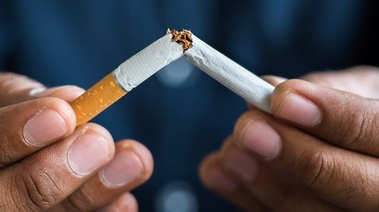Quitting smoking is harder than it looks. One may think quitting smoking means you stop picking up cigarettes. However, the nicotine in cigarettes can be addictive, making it harder to quit.1 Although some people who give up smoking don’t experience withdrawal symptoms, many people continue to have strong cravings for cigarettes after they first quit.1 While quitting smoking is a difficult process, knowing how to properly manage withdrawal symptoms can make the process go more smoothly. Learn more about withdrawal symptoms and find tips on quitting smoking below.
Common smoking withdrawal symptoms
One of the most common withdrawal symptoms from quitting smoking is getting constant urges and cravings to smoke.2 Most people who smoke regularly have urges to smoke once they quit, and these urges can range from mild to overwhelming.2 Learning to overcome these urges can help you quit easier and stay focused on your goals. Other nicotine withdrawal symptoms include feeling irritated or restless, having a hard time concentrating, having trouble sleeping, and feeling hungry, anxious or frustrated.2
Although the list of possible withdrawal symptoms may seem overwhelming, not everyone experiences the same symptoms. By identifying what symptoms to look out for when quitting smoking, you will be better prepared when starting the process of withdrawal.
Tips on quitting smoking
"Dealing with withdrawal symptoms and cravings can be tough, but any symptom can be managed with the right help. Quitting smoking is a process that requires plenty of time, patience and new healthy habits."
Here are some quit smoking tips to help you get through the toughest withdrawal symptoms.
1. Find substitutes for cigarettes to keep your hands occupied
A good way to start your quit is to find substitutes to cigarettes to keep your hands and mouth occupied.3 Use objects like straws, vegetable sticks, or lip balms and hold them by your mouth. It may look silly holding something by your mouth to mimic a cigarette. However, this can make you feel like you are smoking and help with your urge to hold a cigarette.3 You can also use de-stressors like stress balls and pencils for doodling to help deal with nervous energy that can lead to craving a cigarette.3
2. Becoming (and staying) physically active
Being physically active has many benefits to your health, and it can also help with the quit-smoking process. In fact, physical activity can help you with the quit-smoking process in many ways. First, physical activity can be a great distraction from your desire to smoke. A good way to deal with an urge to smoke is to drown out the feeling by focusing your attention on something different or more interesting.3 If you can, put on your headphones and go for a quick walk any time you feel the urge to grab a cigarette so you can literally walk away from your cravings. Physical activity can also help you any time you feel restless or jumpy as a result of your withdrawal symptoms.3 A short run or workout can shake off the jitters from any nervous energy caused by nicotine cravings.2
Since one of the common withdrawal symptoms is frequent feelings of hunger, the potential for weight gain is another thing to look out for after quitting smoking. Your body doesn’t burn calories as fast when you first quit, and you may eat more because of the stress of quitting or to have something to do with your hands and mouth.2 By opting for smarter snacking choices and exercising more regularly, you can control weight gain after quitting. Because your lungs, heart, and circulatory system will function better after quitting, working out and staying physically active will get easier over time.3
3. Nicotine replacement products
Nicotine replacement products are a helpful tool to use when quitting smoking. When you quit smoking, you may need support to cope with your body’s desire for nicotine, and nicotine replacement products help some smokers quit.1 Try nicotine replacement products like Nicorette Gum or Nicorette Lozenges for discreet, over-the-counter relief that tastes great. Nicorette products work by delivering therapeutic doses of nicotine to help you gradually reduce your dependence on nicotine. Find flavors like Spearmint Burst and Fruit Chill that make the quit smoking process easier and better tasting.
4. Identify your smoking triggers
A lot of different things can trigger your urge to smoke, and it’s important to know what they are when you’re trying to quit. Smoking cravings can be triggered by things that make you think of smoking, including people that you smoked with or places where you used to smoke.2 Prepare yourself for smoking cravings every time you encounter a trigger, telling yourself that you don’t need to smoke. Every nicotine craving passes with time, and the best thing you can do for yourself is to wait it out.2
By knowing what to do to quit smoking, a healthy smoke-free life is possible for anyone. Find natural remedies to help quit smoking and other helpful tips on the Nicorette Support Hub.
- Quitting Smoking for Older Adults. National Institute of Aging. https://www.nia.nih.gov/health/quitting-smoking-older-adults. Accessed 9/8/2021.
- 7 Common Withdrawal Symptoms. Centers for Disease Control and Prevention. https://www.cdc.gov/tobacco/campaign/tips/quit-smoking/7-common-withdrawal-symptoms/index.html Accessed 9/8/2021.
- Tips for Quitting. Centers for Disease Control and Prevention. https://www.cdc.gov/tobacco/campaign/tips/quit-smoking/quit-smoking-medications/tips-for-quitting/index.html Accessed 9/8/2021.






